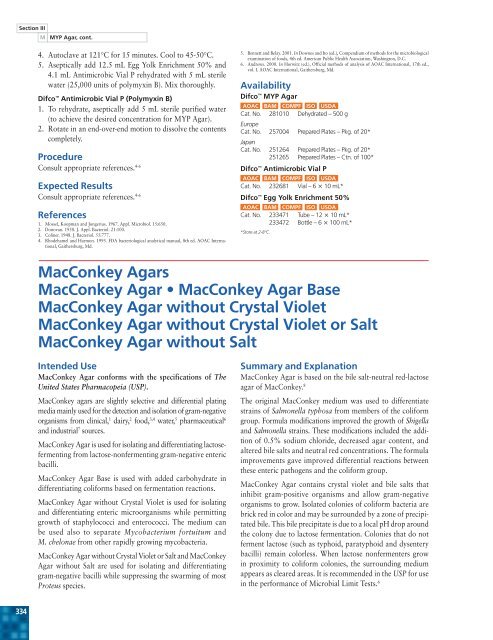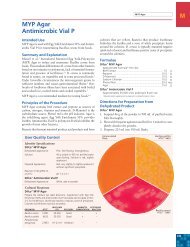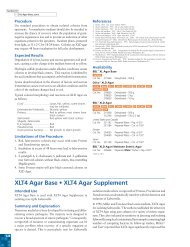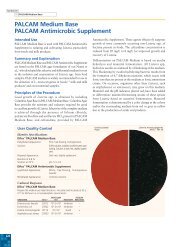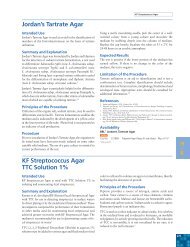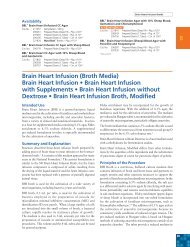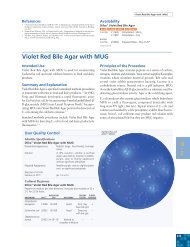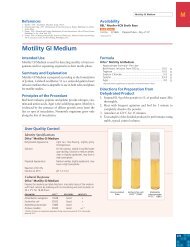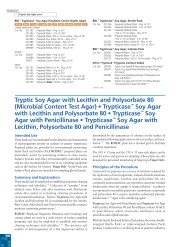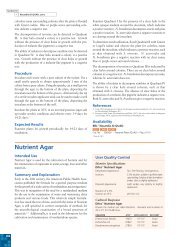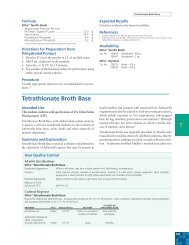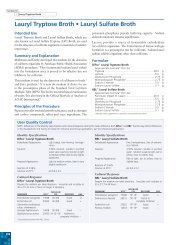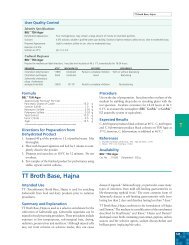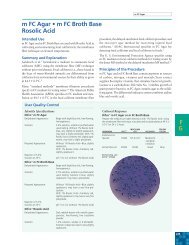MacConkey Agars MacConkey Agar ⢠MacConkey ... - BVA Scientific
MacConkey Agars MacConkey Agar ⢠MacConkey ... - BVA Scientific
MacConkey Agars MacConkey Agar ⢠MacConkey ... - BVA Scientific
Create successful ePaper yourself
Turn your PDF publications into a flip-book with our unique Google optimized e-Paper software.
Section IIIM MYP <strong>Agar</strong>, cont.4. Autoclave at 121°C for 15 minutes. Cool to 45-50°C.5. Aseptically add 12.5 mL Egg Yolk Enrichment 50% and4.1 mL Antimicrobic Vial P rehydrated with 5 mL sterilewater (25,000 units of polymyxin B). Mix thoroughly.Difco Antimicrobic Vial P (Polymyxin B)1. To rehydrate, aseptically add 5 mL sterile purified water(to achieve the desired concentration for MYP <strong>Agar</strong>).2. Rotate in an end-over-end motion to dissolve the contentscompletely.ProcedureConsult appropriate references. 4-6Expected ResultsConsult appropriate references. 4-6References1. Mossel, Koopman and Jongerius. 1967. Appl. Microbiol. 15:650.2. Donovan. 1958. J. Appl. Bacteriol. 21:100.3. Coliner. 1948. J. Bacteriol. 55:777.4. Rhodehamel and Harmon. 1995. FDA bacteriological analytical manual, 8th ed. AOAC International,Gaithersburg, Md.5. Bennett and Belay. 2001. In Downes and Ito (ed.), Compendium of methods for the microbiologicalexamination of foods, 4th ed. American Public Health Association, Washington, D.C.6. Andrews. 2000. In Horwitz (ed.), Official methods of analysis of AOAC International, 17th ed.,vol. I. AOAC International, Gaithersburg, Md.AvailabilityDifco MYP <strong>Agar</strong>AOAC BAM COMPF ISO USDACat. No. 281010 Dehydrated – 500 gEuropeCat. No. 257004 Prepared Plates – Pkg. of 20*JapanCat. No. 251264 Prepared Plates – Pkg. of 20*251265 Prepared Plates – Ctn. of 100*Difco Antimicrobic Vial PAOAC BAM COMPF ISO USDACat. No. 232681 Vial – 6 × 10 mL*Difco Egg Yolk Enrichment 50%AOAC BAM COMPF ISO USDACat. No. 233471 Tube – 12 × 10 mL*233472 Bottle – 6 × 100 mL**Store at 2-8°C.<strong>MacConkey</strong> <strong><strong>Agar</strong>s</strong><strong>MacConkey</strong> <strong>Agar</strong> • <strong>MacConkey</strong> <strong>Agar</strong> Base<strong>MacConkey</strong> <strong>Agar</strong> without Crystal Violet<strong>MacConkey</strong> <strong>Agar</strong> without Crystal Violet or Salt<strong>MacConkey</strong> <strong>Agar</strong> without SaltIntended Use<strong>MacConkey</strong> <strong>Agar</strong> conforms with the specifications of TheUnited States Pharmacopeia (USP).<strong>MacConkey</strong> agars are slightly selective and differential platingmedia mainly used for the detection and isolation of gram-negativeorganisms from clinical, 1 dairy, 2 food, 3,4 water, 5 pharmaceutical 6and industrial 7 sources.<strong>MacConkey</strong> <strong>Agar</strong> is used for isolating and differentiating lactosefermentingfrom lactose-nonfermenting gram-negative entericbacilli.<strong>MacConkey</strong> <strong>Agar</strong> Base is used with added carbohydrate indifferentiating coliforms based on fermentation reactions.<strong>MacConkey</strong> <strong>Agar</strong> without Crystal Violet is used for isolatingand differentiating enteric microorganisms while permittinggrowth of staphylococci and enterococci. The medium canbe used also to separate Mycobacterium fortuitum andM. chelonae from other rapidly growing mycobacteria.<strong>MacConkey</strong> <strong>Agar</strong> without Crystal Violet or Salt and <strong>MacConkey</strong><strong>Agar</strong> without Salt are used for isolating and differentiatinggram-negative bacilli while suppressing the swarming of mostProteus species.Summary and Explanation<strong>MacConkey</strong> <strong>Agar</strong> is based on the bile salt-neutral red-lactoseagar of <strong>MacConkey</strong>. 8The original <strong>MacConkey</strong> medium was used to differentiatestrains of Salmonella typhosa from members of the coliformgroup. Formula modifications improved the growth of Shigellaand Salmonella strains. These modifications included the additionof 0.5% sodium chloride, decreased agar content, andaltered bile salts and neutral red concentrations. The formulaimprovements gave improved differential reactions betweenthese enteric pathogens and the coliform group.<strong>MacConkey</strong> <strong>Agar</strong> contains crystal violet and bile salts thatinhibit gram-positive organisms and allow gram-negativeorganisms to grow. Isolated colonies of coliform bacteria arebrick red in color and may be surrounded by a zone of precipitatedbile. This bile precipitate is due to a local pH drop aroundthe colony due to lactose fermentation. Colonies that do notferment lactose (such as typhoid, paratyphoid and dysenterybacilli) remain colorless. When lactose nonfermenters growin proximity to coliform colonies, the surrounding mediumappears as cleared areas. It is recommended in the USP for usein the performance of Microbial Limit Tests. 6334
<strong>MacConkey</strong> <strong><strong>Agar</strong>s</strong>, cont.User Quality ControlNOTE: Differences in the Identity Specifications and Cultural Response testing for media offered as both Difco and BBL brands may reflect differencesin the development and testing of media for industrial and clinical applications, per the referenced publications.MIdentity SpecificationsDifco <strong>MacConkey</strong> <strong>Agar</strong>Dehydrated Appearance: Pink to pinkish beige, free-flowing,homogeneous.Solution:5.0% solution, soluble in purifiedwater upon boiling. Solution is reddishpurple, slightly opalescent.Prepared Appearance: Reddish purple, slightly opalescent.Reaction of 5.0%Solution at 25°C: pH 7.1 ± 0.2Difco <strong>MacConkey</strong> <strong>Agar</strong> BaseDehydrated Appearance: Pink to pinkish beige, free-flowing,homogeneous.Solution:4.0% solution, soluble in purifiedwater upon boiling. Solution is red,very slightly to slightly opalescent.Prepared Appearance: Red, slightly opalescent.Reaction of 4.0%Solution at 25°C: pH 7.1 ± 0.2Difco <strong>MacConkey</strong> <strong>Agar</strong> without Crystal VioletDehydrated Appearance: Pinkish beige, free-flowing, homogeneous.Solution:5.2% solution, soluble in purifiedwater upon boiling. Solution is reddishorange, clear to very slightlyopalescent.Prepared Appearance: Reddish orange, slightly opalescent.Reaction of 5.2%Solution at 25°C: pH 7.4 ± 0.2Difco <strong>MacConkey</strong> <strong>Agar</strong> without SaltDehydrated Appearance: Pinkish beige, free-flowing, homogeneous.Solution:4.7% solution, soluble in purifiedwater upon boiling. Solution is reddishorange, slightly opalescent.Prepared Appearance: Reddish orange, slightly opalescent.Reaction of 4.7%Solution at 25°C: pH 7.4 ± 0.2ContinuedIdentity SpecificationsBBL <strong>MacConkey</strong> <strong>Agar</strong>Dehydrated Appearance:Fine, homogenous, may contain darkparticles.Solution:5.0% solution, soluble in purifiedwater upon boiling. Solution is mediumto dark, rose to brown-rose with orwithout a trace orange tint, clear toslightly hazy.Prepared Appearance: Medium to dark, rose to brown-rosewith or without a trace orange tint,clear to slightly hazy.Reaction of 5.0%Solution at 25°C: pH 7.1 ± 0.2BBL <strong>MacConkey</strong> <strong>Agar</strong> without Crystal VioletDehydrated Appearance: Fine, homogeneous, free of extraneousmaterial.Solution:5.2% solution, soluble in purifiedwater upon boiling. Solution is medium,red-orange to red-rose, slightly hazyto hazy.Prepared Appearance: Medium, red-orange to red-rose,slightly hazy to hazy.Reaction of 5.2%Solution at 25°C: pH 7.4 ± 0.2BBL <strong>MacConkey</strong> <strong>Agar</strong> without Crystal Violet or SaltDehydrated Appearance: Fine, homogeneous, free of extraneousmaterial.Solution:4.37% solution, soluble in purifiedwater upon boiling. Solution is medium,red-orange to red-rose, slightly hazyto hazy.Prepared Appearance: Medium, red-orange to red-rose,slightly hazy to hazy.Reaction of 4.37%Solution at 25°C: pH 7.4 ± 0.2Continued<strong>MacConkey</strong> <strong>Agar</strong> Base is prepared without added carbohydrates,which permits their addition either individually or in combination.It is recommended that carbohydrates such as sucrose orlactose be added in a concentration of 1% to the basalmedium.<strong>MacConkey</strong> <strong>Agar</strong> without Crystal Violet is a differentialmedium that is less selective than <strong>MacConkey</strong> <strong>Agar</strong>. The lackof crystal violet permits the growth of Staphylococcus andEnterococcus. Staphylococci produce pale pink to red coloniesand enterococci produce compact tiny red colonies either onor beneath the surface of the medium. The medium is usedalso to separate Mycobacterium fortuitum and M. chelonaefrom other rapidly growing mycobacteria. 9,10<strong>MacConkey</strong> <strong>Agar</strong> without Crystal Violet or Salt and <strong>MacConkey</strong><strong>Agar</strong> without Salt (which also lacks crystal violet) are differentialmedia used for isolating and cultivating gram-negativeenteric organisms and gram-positive cocci from waters, fecesand other sources suspected of containing these organisms, aswell as limiting the swarming of Proteus species.Principles of the ProcedurePeptones are sources of nitrogen and other nutrients. Lactoseis a fermentable carbohydrate. When lactose is fermented, alocal pH drop around the colony causes a color change in thepH indicator (neutral red) and bile precipitation. Bile salts,bile salts no. 3, oxgall and crystal violet are selective agentsthat inhibit growth of gram-positive organisms. <strong>Agar</strong> is thesolidifying agent.335
Section IIIM <strong>MacConkey</strong> <strong><strong>Agar</strong>s</strong>, cont.Cultural ResponseDifco <strong>MacConkey</strong> <strong>Agar</strong> or Difco <strong>MacConkey</strong><strong>Agar</strong> BasePrepare the medium per label directions. For <strong>MacConkey</strong> <strong>Agar</strong> Base,prepare without and with 1% added lactose. Inoculate and incubate at35 ± 2°C for 18-24 hours (and 40-48 hours for E. coli).INOCULUM COLONY BILEORGANISM ATCC CFU RECOVERY COLOR PPT.Enterococcus faecalis 29212 10 3 -2×10 3 Partial to – –completeinhibitionEscherichia coli 25922 10 2 -10 3 Good Pink to red; +w/o lactose:Colorless –Proteus mirabilis 12453 10 2 -10 3 Good Colorless –Salmonella choleraesuissubsp. choleraesuisserotype Typhimurium 14028 10 2 -10 3 Good Colorless –Difco <strong>MacConkey</strong> <strong>Agar</strong> without Crystal VioletPrepare the medium per label directions. Inoculate and incubate at 35 ±2°C for 18-48 hours.INOCULUM COLONY BILEORGANISM ATCC CFU RECOVERY COLOR PPT.Enterococcus faecalis 29212 10 2 -10 3 Good Red –Escherichia coli 25922 10 2 -10 3 Good Pink to red –Proteus mirabilis 12453 10 2 -10 3 Good Colorless –Salmonella choleraesuissubsp. choleraesuisserotype Typhimurium 14028 10 2 -10 3 Good Colorless –Difco <strong>MacConkey</strong> <strong>Agar</strong> without SaltPrepare the medium per label directions. Inoculate and incubate at 35 ±2°C for 18-48 hours.INOCULUM COLONY BILEORGANISM ATCC CFU RECOVERY COLOR PPT.Enterococcus faecalis 33186 10 2 -10 3 Good Red –Escherichia coli 25922 10 2 -10 3 Good Pink to red –Proteus mirabilis 12453 10 2 -10 3 Good Colorless, –no swarmingSalmonella choleraesuissubsp. choleraesuisserotype Typhimurium 14028 10 2 -10 3 Good Colorless –Shigella flexneri 12022 10 2 -10 3 Good Colorless –Cultural ResponseBBL <strong>MacConkey</strong> <strong>Agar</strong>Prepare the medium per label directions. Inoculate and incubate at35 ± 2°C for 18-24 hours (and 40-48 hours for E. coli).INOCULUM COLONY BILEORGANISM ATCC CFU RECOVERY COLOR PPT.Enterococcus faecalis 29212 10 3 -2×10 3 Partial to – –completeinhibitionEscherichia coli 25922 10 2 -10 3 Good Pink to +rose-redProteus mirabilis 12453 10 2 -10 3 Good Colorless –Salmonella choleraesuissubsp. choleraesuisserotype Typhimurium 14028 10 2 -10 3 Good Colorless –BBL <strong>MacConkey</strong> <strong>Agar</strong> without Crystal VioletPrepare the medium per label directions. Inoculate and incubate at35 ± 2°C for 18-24 hours and up to 48 hours if necessary (up to 11days for M. fortuitum).INOCULUM COLONY BILEORGANISM ATCC CFU RECOVERY COLOR PPT.Enterococcus faecalis 29212 10 3 -10 4 Good Rose-red –Escherichia coli 25922 10 3 -10 4 Good Pink to –rose-redMycobacteriumfortuitum 6841 10 3 -10 4 Good Rose-red –Salmonella choleraesuissubsp. choleraesuisserotype Typhimurium 14028 10 3 -10 4 Good Colorless –Staphylococcus aureus 25923 10 3 -10 4 Good Pink to –rose-redBBL <strong>MacConkey</strong> <strong>Agar</strong> without Crystal Violet or SaltPrepare the medium per label directions. Inoculate and incubate at35 ± 2°C for 18-24 hours and up to 48 hours if necessary.INOCULUM COLONY BILEORGANISM ATCC CFU RECOVERY COLOR PPT.Enterococcus faecalis 29212 10 3 -10 4 Good Rose-red –Escherichia coli 25922 10 3 -10 4 Good Pink to –rose-redProteus mirabilis 12453 10 3 -10 4 Good Colorless, –no swarmingSalmonella choleraesuissubsp. choleraesuisserotype Typhimurium 14028 10 3 -10 4 Good Colorless –336FormulaeDifco <strong>MacConkey</strong> <strong>Agar</strong>Approximate Formula* Per LiterPeptone ................................................................... 17.0 gProteose Peptone ....................................................... 3.0 gLactose ..................................................................... 10.0 gBile Salts No. 3 ........................................................... 1.5 gSodium Chloride ........................................................ 5.0 g<strong>Agar</strong> ......................................................................... 13.5 gNeutral Red ................................................................ 0.03 gCrystal Violet .............................................................. 1.0 mgDifco <strong>MacConkey</strong> <strong>Agar</strong> BaseConsists of the same ingredients without the lactose.BBL <strong>MacConkey</strong> <strong>Agar</strong>Approximate Formula* Per LiterPancreatic Digest of Gelatin ..................................... 17.0 gPancreatic Digest of Casein ........................................ 1.5 gPeptic Digest of Animal Tissue ................................... 1.5 gLactose ..................................................................... 10.0 gBile Salts ..................................................................... 1.5 gSodium Chloride ........................................................ 5.0 g<strong>Agar</strong> ......................................................................... 13.5 gNeutral Red ................................................................ 0.03 gCrystal Violet .............................................................. 1.0 mgDifco <strong>MacConkey</strong> <strong>Agar</strong> without Crystal VioletApproximate Formula* Per LiterPeptone ................................................................... 20.0 gLactose ..................................................................... 10.0 gBile Salts ..................................................................... 5.0 gSodium Chloride ........................................................ 5.0 g<strong>Agar</strong> ......................................................................... 12.0 gNeutral Red ................................................................ 0.05 g
UninoculatedPlate<strong>MacConkey</strong> <strong>Agar</strong> w/o CVEscherichia coliATCC 25922<strong>MacConkey</strong> <strong><strong>Agar</strong>s</strong>, cont.2. Heat with frequent agitation and boil for 1 minute to completelydissolve the powder.3. Autoclave at 121°C for 15 minutes.NOTE: If <strong>MacConkey</strong> <strong>Agar</strong> Base is to be used within 12 hours,omit autoclaving and gently boil medium for 5 minutes.Add 1% carbohydrate before or after autoclaving, dependingupon heat lability. The surface of <strong>MacConkey</strong> agars withoutsalt should be thoroughly air-dried prior to inoculation.4. Test samples of the finished product for performance usingstable, typical control cultures.MProcedureFor procedures on the isolation and identification of entericorganisms consult the appropriate references.ProteusmirabilisATCC 12453BBL <strong>MacConkey</strong> <strong>Agar</strong> without Crystal VioletApproximate Formula* Per LiterPancreatic Digest of Casein ...................................... 10.0 gPeptic Digest of Animal Tissue ................................. 10.0 gLactose ..................................................................... 10.0 gBile Salts ..................................................................... 5.0 gSodium Chloride ........................................................ 5.0 g<strong>Agar</strong> ......................................................................... 12.0 gNeutral Red ................................................................ 0.05 gDifco <strong>MacConkey</strong> <strong>Agar</strong> without SaltApproximate Formula* Per LiterPeptone ................................................................... 20.0 gLactose ..................................................................... 10.0 gBile Salts ..................................................................... 5.0 g<strong>Agar</strong> ......................................................................... 12.0 gNeutral Red .............................................................. 75.0 mgBBL <strong>MacConkey</strong> <strong>Agar</strong> without Crystal Violet or SaltApproximate Formula* Per LiterPancreatic Digest of Gelatin ..................................... 10.0 gYeast Extract ............................................................ 10.0 gLactose ..................................................................... 10.0 gOxgall......................................................................... 5.0 gMagnesium Sulfate .................................................... 0.2 g<strong>Agar</strong> ......................................................................... 12.0 gNeutral Red .............................................................. 75.0 mg*Adjusted and/or supplemented as required to meet performance criteria.SalmonellatyphimuriumATCC 14028Directions for Preparation fromDehydrated Product1. Suspend the powder in 1 L of purified water:Difco <strong>MacConkey</strong> <strong>Agar</strong> – 50 g;BBL <strong>MacConkey</strong> <strong>Agar</strong> – 50 g;Difco <strong>MacConkey</strong> <strong>Agar</strong> Base – 40 g;Difco <strong>MacConkey</strong> <strong>Agar</strong> without Crystal Violet – 52 g;BBL <strong>MacConkey</strong> <strong>Agar</strong> without Crystal Violet – 52 g;BBL <strong>MacConkey</strong> <strong>Agar</strong> without Crystal Violet or Salt –47.3 g;Difco <strong>MacConkey</strong> <strong>Agar</strong> without Salt – 47 g.Mix thoroughly.Expected ResultsLactose-fermenting organisms grow as pink to brick-red colonieswith or without a zone of precipitated bile. Lactose-nonfermentingorganisms grow as colorless or clear colonies.Swarming by Proteus spp. is reduced on <strong>MacConkey</strong> agarswithout salt.On <strong>MacConkey</strong> <strong>Agar</strong> without Crystal Violet and <strong>MacConkey</strong>agars without salt, staphylococci produce pale pink to redcolonies and enterococci produce tiny red colonies; theseorganisms are inhibited on <strong>MacConkey</strong> <strong>Agar</strong>.On <strong>MacConkey</strong> <strong>Agar</strong> without Crystal Violet, potentiallypathogenic rapid growers of the M. fortuitum complexusually grow in 5-11 days, while the commonly saprophyticspecies are inhibited. 9,10On <strong>MacConkey</strong> agars without salt, the swarming of Proteusis reduced.Limitations of the Procedure1. Although <strong>MacConkey</strong> media are selective primarily forgram-negative enteric bacilli, biochemical and, if indicated,serological testing using pure cultures are recommendedfor complete identification. Consult appropriate referencesfor further information. 1,32. Incubation of <strong>MacConkey</strong> <strong>Agar</strong> plates under increased CO 2has been reported to reduce the growth and recovery of anumber of strains of gram-negative bacilli. 113. Some strains of M. smegmatis from humans may grow on<strong>MacConkey</strong> <strong>Agar</strong> without Crystal Violet, but these strainscan be differentiated from M. fortuitum complex by the3-day arylsulfatase test. 9337
Section IIIM <strong>MacConkey</strong> <strong><strong>Agar</strong>s</strong>, cont.References1. Bopp, Brenner, Wells and Strockbine. 1999. In Murray, Baron, Pfaller, Tenover and Yolken (ed.),Manual of clinical microbiology, 7th ed. American Society for Microbiology, Washington, D.C.2. Flowers, Andrews, Donnelly and Koenig. 1993. In Marshall (ed.), Standard methods for theexamination of dairy products. 16th ed., American Public Health Association, Washington, D.C.3. Downes and Ito (ed.). 2001. Compendium of methods for the microbiological examination of foods,4th ed. American Public Health Association, Washington. D.C.4. U.S. Food and Drug Administration. 1995. Bacteriological analytical manual, 8th ed. AOAC International,Gaithersburg, Md.5. Clesceri, Greenberg and Eaton (ed.). 1998. Standard methods for the examination of water andwastewater, 20th ed. American Public Health Association, Washington, D.C.6. United States Pharmacopeial Convention, Inc. 2001. The United States pharmacopeia 25/Thenational formulary 20 – 2002. United States Pharmacopeial Convention, Inc., Rockville, Md.7. Horwitz (ed.). 2000. Official methods of analysis of AOAC International, 17th ed. AOAC International,Gaithersburg, Md.8. <strong>MacConkey</strong>. 1905. J. Hyg. 5:333.9. Kent and Kubica. 1985. Public health mycobacteriology: a guide for the level III laboratory. USDHHS,Centers for Disease Control, Atlanta, Ga.10. Master. 1994. In Isenberg (ed.), Clinical microbiology procedures handbook, vol. 1, suppl. 1. AmericanSociety for Microbiology, Washington, D.C.11. Mazura-Reetz, Neblett and Galperin. 1979. Abstr. C179, p. 339. Abstr. Annu. Meet. AmericanSociety for Microbiology 1979.AvailabilityDifco <strong>MacConkey</strong> <strong>Agar</strong>AOAC BAM CCAM COMPF EP SMD SMWW USPCat. No. 212123 Dehydrated – 500 g212122 Dehydrated – 2 kg275300 Dehydrated – 10 kgBBL <strong>MacConkey</strong> <strong>Agar</strong>AOAC BAM CCAM COMPF EP SMD SMWW USPCat. No. 211387 Dehydrated – 500 g211390 Dehydrated – 5 lb (2.3 kg)211391 Dehydrated – 25 lb (11.3 kg)Difco <strong>MacConkey</strong> <strong>Agar</strong> BaseCat. No. 281810 Dehydrated – 500 gDifco <strong>MacConkey</strong> <strong>Agar</strong> without Crystal VioletCat. No. 247010 Dehydrated – 500 gBBL <strong>MacConkey</strong> <strong>Agar</strong> without Crystal VioletCat. No. 211393 Dehydrated – 500 gEuropeCat. No. 256008 Prepared Plates – Pkg. of 20*BBL <strong>MacConkey</strong> <strong>Agar</strong> without Crystal Violet or SaltCat. No. 294584 Dehydrated – 500 g297901 Prepared Plates – Ctn. of 100*Difco <strong>MacConkey</strong> <strong>Agar</strong> without SaltCat. No. 233120 Dehydrated – 500 g233110 Dehydrated – 10 kgEuropeCat. No. 256009 Prepared Plates – Pkg. of 20**Store at 2-8°C.<strong>MacConkey</strong> II <strong>Agar</strong> • <strong>MacConkey</strong> II <strong>Agar</strong> with MUG338Intended Use<strong>MacConkey</strong> II <strong>Agar</strong> conforms with specifications of The UnitedStates Pharmacopeia (USP).<strong>MacConkey</strong> II <strong>Agar</strong> is a slightly selective and differential mediumfor the detection of coliform organisms and enteric pathogens.<strong>MacConkey</strong> II <strong>Agar</strong> with MUG is used for the presumptiveidentification of Escherichia coli.Summary and ExplanationThe BBL <strong>MacConkey</strong> II <strong>Agar</strong> formulation was made availablein 1983. It was specially designed to improve the inhibitionof swarming Proteus species, to achieve more definitive differentiationof lactose fermenters and nonfermenters, and for thepromotion of superior growth of enteric pathogens.Trepeta and Edberg 1 modified <strong>MacConkey</strong> <strong>Agar</strong> by the incorporationof MUG (4-methylumbelliferyl-β-D-glucuronide). Theresulting medium allowed the authors to presumptivelyidentify E. coli from the primary plating medium within 5minutes.Principles of the Procedure<strong>MacConkey</strong> II <strong>Agar</strong> is a selective and differential medium. Itis only slightly selective since the concentration of bile salts,which inhibit gram-positive microorganisms, is low in comparisonwith other enteric plating media. Crystal violet also isincluded in the medium to inhibit the growth of gram-positivebacteria, especially enterococci and staphylococci.Differentiation of enteric microorganisms is achieved bythe combination of lactose and the neutral red indicator.Colorless or pink to red colonies are produced depending uponthe ability of the isolate to ferment the carbohydrate.Most strains (96-97%) of E. coli produce β-D-glucuronidase. 2The enzyme hydrolyzes MUG to yield 4-methylumbelliferone,a compound that fluoresces under long-wave (366 nm)UV light. The addition of MUG to the formulation allowsβ-D-glucuronidase-positive strains of E. coli to fluoresceblue-green when examined under UV light.BBL <strong>MacConkey</strong> II <strong>Agar</strong> with MUG contains 0.1 g of MUGper liter of <strong>MacConkey</strong> II <strong>Agar</strong>.FormulaBBL <strong>MacConkey</strong> II <strong>Agar</strong>Approximate Formula* Per LiterPancreatic Digest of Gelatin ..................................... 17.0 gPancreatic Digest of Casein ........................................ 1.5 gPeptic Digest of Animal Tissue ................................... 1.5 gLactose ..................................................................... 10.0 gBile Salts ..................................................................... 1.5 gSodium Chloride ........................................................ 5.0 g<strong>Agar</strong> ......................................................................... 13.5 gNeutral Red ................................................................ 0.03 gCrystal Violet .............................................................. 1.0 mg*Adjusted and/or supplemented as required to meet performance criteria.Directions for Preparation fromDehydrated Product1. Suspend 50 g of the powder in 1 L of purified water. Mixthoroughly.2. Heat with frequent agitation and boil for 1 minute tocompletely dissolve the powder.3. Autoclave at 121°C for 15 minutes.4. Test samples of the finished product for performance usingstable, typical control cultures.


